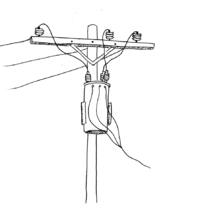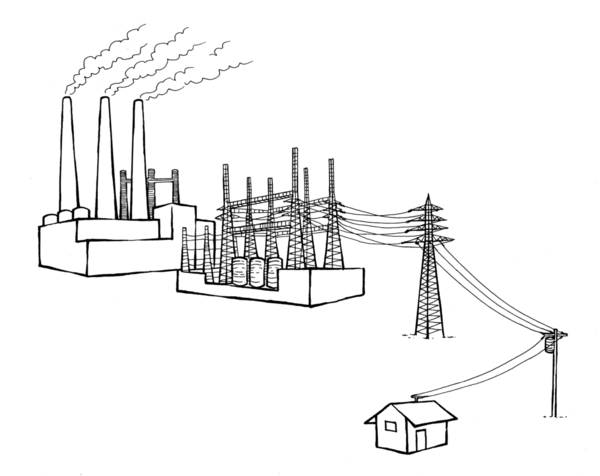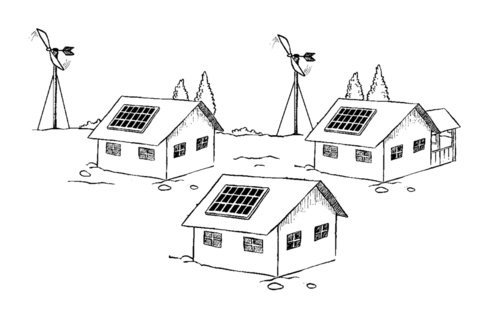Hesperian Health Guides
Energy Distribution
HealthWiki > A Community Guide to Environmental Health > Chapter 23: Clean Energy > Energy Distribution
Large power plants run by private industry and governments generate electricity and distribute it through high-voltage wires to different areas. Then the electricity passes through transformers (machines that change the electricity from high voltage to a lower voltage that can be used in homes and businesses). Low voltage wires bring the electricity into houses or factories to run lights and machines.

|
| Transformer |
The problem with the way most electricity is produced today is not only that it is dirty, but that it is produced on a very large scale and sent over long distances. This is very expensive. Because this distribution system is so expensive, smaller communities may wait years for the national electric system to arrive, if it ever arrives at all. So most electricity goes to the biggest users: industry and cities.

electricity through high-voltage
wires over long distances
Clean energy from wind, sun, and water can be made in smaller quantities at a lower cost, so clean energy is easier to use close to where it is produced. Communities that use clean energy can have control over their own energy resources. When electricity is made locally from sunlight, water, or biogas, it reduces dependence on fossil fuels, and on expensive, high-voltage distribution systems. It also avoids having faraway government agencies or large corporations setting prices and controlling where the energy can go.

Clean energy works best if a mix of different sources is used. If one source becomes unavailable, such as sunshine on cloudy days, or falling water in the dry season, the other sources are still able to make power.
Fossil fuel energy distributes electricity, dependence, and pollution. Clean energy distributes electricity, independence, self-reliance, and sustainability.
Solar-powered rural clinics
In a remote part of Burma near the border of Thailand, people of the Karen ethnic community live in constant struggle with the Burmese military. Due to this oppression, no governmental or non-governmental organization (NGO) is able to provide health care in this area. But Karen groups on the Thailand side of the border have built a network of medics supporting over 28 clinics that care for almost 100,000 people in the region. The medics treat land mine victims and other people wounded in the conflict, as well as other health problems.
Three NGOs, Green Empowerment, Sun Power Energy International, and a local group called Border Green Energy Team, brought solar panels and batteries to the border and trained Karen villagers, refugees, and medics to assemble and use them. The medics carried the equipment through the jungle. Now all 28 clinics in the war zone have electricity to run lights, laptop computers, and life-saving medical equipment, and villagers know how to repair and maintain their own solar energy systems.


